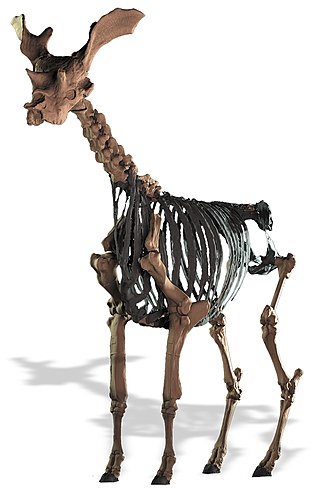
Megophryidae, commonly known as goose frogs, is a large family of frogs native to the warm southeast of Asia, from the Himalayan foothills eastwards, south to Indonesia and the Greater Sunda Islands in Maritime Southeast Asia, and extending to the Philippines. Fossil remains are also known from North America. As of 2014 it encompasses 246 species of frogs divided between five genera. For lack of a better vernacular name, they are commonly called megophryids.

Kannemeyeria is a genus of dicynodont that lived during the Anisian age of Middle Triassic period in what is now Africa and South America. The generic name is given in honor of Daniel Rossouw Kannemeyer, the South African fossil collector who discovered the original specimen. It is one of the first representatives of the family, and hence one of the first large herbivores of the Triassic.

The Seventeenth Dynasty of Egypt was a dynasty of pharaohs that ruled in Upper Egypt during the late Second Intermediate Period, approximately from 1580 to 1550 BC. Its mainly Theban rulers are contemporary with the Hyksos of the Fifteenth Dynasty and succeed the Sixteenth Dynasty, which was also based in Thebes.

Agriotherium is an extinct genus of bears whose fossils are found in Miocene through Pleistocene-aged strata of North America, Eurasia, and Africa. This long-lived genus persisted from at least ~11.6–2.5 Mya. Materials from the late-surviving A. africanum in Africa have suggested that A. africanum died out during the early Gelasian.

Sivatherium is an extinct genus of giraffids that ranged throughout Africa to the Indian subcontinent. The species Sivatherium giganteum is, by weight, one of the largest giraffids known, and also one of the largest ruminants of all time.
Juju or ju-ju is a spiritual belief system incorporating objects, such as amulets, and spells used in religious practice in West Africa by the people of Nigeria, Benin, Togo, Ghana, and Cameroon. The term has been applied to traditional African religions, incorporating objects such as amulets, and spells used in spiritual practices, and blood sacrifices.
Kotoshironushi (事代主神), also known as Yae Kotoshironushi no kami (八重言代主神), is a Shinto kami.
Rhadalognathus was a prehistoric crocodile-like amphibian that belongs to the Mastodonsauridae family. Not much is known about this creature but it lived in the Triassic period. Rhadalognathus is also the name of the genus in which the organism belongs within. Rhadalognathus was found in northern Arizona, US, by S. P. Welles in 1947. The size of the organism is unknown but its skull is about 17in long and weighs 7lbs.

Listriodon is an extinct genus of pig-like animals that lived in Eurasia during the Miocene.

Megalohyrax is an extinct hyrax-grouped genus of herbivorous mammal that lived during the Miocene, Oligocene, and Eocene, about 55-11 million years ago. Its fossils have been found in Africa and in Asia Minor.
Gigantohyrax was a genus of herbivorous hyrax-grouped mammals from the Pliocene Shungura Formation of Ethiopia. Fossils have also been found in Makapansgat of South Africa.
Cainochoerinae was a subfamily of even-toed ungulates that existed during the Miocene and Pliocene in Asia and Africa.
Cainochoerus was an extinct genus of even-toed ungulates which lived during the Miocene and Pliocene in Africa. Fossils have been found in Kenya, Ethiopia and South Africa.

Hyotheriinae was a subfamily of even-toed ungulates that existed during the Miocene and Pliocene in Europe, Asia, and Africa.
Nguruwe was an extinct genus of even-toed ungulates that existed during the Miocene in Africa. It was formerly considered a member of the subfamily Listriodontinae, but has since been placed in Hyotheriinae.
Parachleuastochoerus was an extinct genus of even-toed ungulates that existed during the Miocene in Europe. It was a smaller descendant of the Conohyus genus, with narrower cheek teeth and reduced premolars.
Tetraconodon was an extinct genus of even-toed ungulates that existed during the middle and late Miocene in Asia.
Lopholistriodon was an extinct genus of even-toed ungulates that existed during the Miocene in Africa.
Namachoerus was an extinct genus of even-toed ungulates that existed during the Miocene of Africa.








